
Braehead is a commercial development located at the former site of Braehead Power Station in Renfrew on the south bank of the River Clyde in Renfrew, Renfrewshire. It is particularly notable for its large shopping centre, arena and leisure facilities.

The Glasgow Subway is an underground light metro system in Glasgow, Scotland. Opened on 14 December 1896, it is the third-oldest underground rail transit system in Europe after the London Underground and the Budapest Metro. It is also one of the very few railways in the world with a track running gauge of 4 ft wide. Originally a cable railway, the subway was later electrified, but the double-track circular line was never expanded. The line was originally known as the Glasgow District Subway, and was thus the first mass transit system to be known as a "subway"; it was later renamed Glasgow Subway Railway. In 1936 it was renamed the Glasgow Underground. Despite this rebranding, many Glaswegians continued to refer to the network as "the Subway". In 2003, the name "Subway" was officially readopted by its operator, the Strathclyde Partnership for Transport (SPT).

Strathclyde Partnership for Transport (SPT) is a regional transport partnership for the Strathclyde area of western Scotland. It is responsible for planning and coordinating regional transport, especially the public transport system in the area, including responsibility for operating the Glasgow Subway, the third-oldest in the world.

The North Clyde Line is a suburban railway in West Central Scotland. The route is operated by ScotRail. As a result of the incorporation of the Airdrie–Bathgate rail link and the Edinburgh–Bathgate line, this route has become the fourth rail link between Glasgow and Edinburgh.
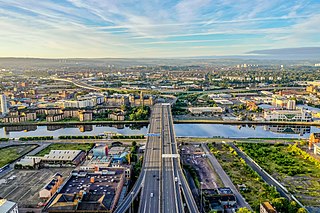
The city of Glasgow, Scotland, has a transport system encompassing air, rail, road and an underground light metro line. Prior to 1962, the city was also served by trams. Commuters travelling into Glasgow from the neighbouring local authorities of North and South Lanarkshire, Renfrewshire, East Renfrewshire, and East and West Dunbartonshire have a major influence on travel patterns, with tens of thousands of residents commuting into the city each day. The most popular mode of transport in the city is the car, used by two-thirds of people for journeys around the city.
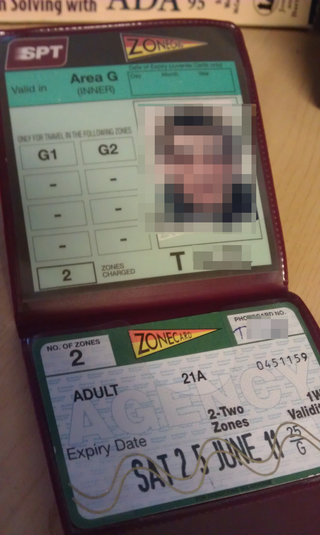
ZoneCard is a travel card issued by the Strathclyde Partnership for Transport, formerly Strathclyde Passenger Transport in Scotland.
First Stop Travel was a Scottish bus company, which operated primarily in Renfrewshire and southwest Glasgow. Its depot was located in Muriel Street, Barrhead. It was closed in 2008 after the Traffic Commissioner revoked its licence.

The British Rail Class 318 is an electric multiple unit (EMU) passenger train which operates in west central Scotland. The units were introduced on 29 September 1986 as part of the electrification of the Ayrshire Coast Line between Glasgow Central and Ayr/Ardrossan with alternating current (AC) overhead lines. Their use was extended to Largs in January 1987. They were also used on the Inverclyde Line in small numbers. The trains currently operate Argyle Line, Cathcart Circle Line, North Clyde Line, Whifflet Line and Inverclyde Line services. Following the withdrawal of the Class 314 fleet in 2019, these units are the oldest working EMUs in Scotland, having been in revenue-earning service for more than 37 years.
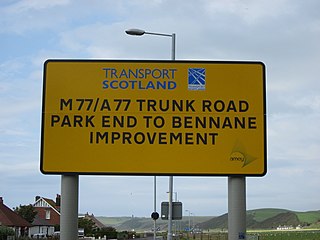
The transport system in Scotland is generally well-developed. The Scottish Government and Scottish Parliament has control over most elements of transport policy within Scotland, with the Cabinet Secretary for Transport, Net Zero and Just Transition holding portfolio responsibility within the Scottish Government. Transport Scotland is the Executive Agency responsible for the Scottish transport network.

Cambuslang railway station is a railway station which serves the town of Cambuslang, South Lanarkshire, Scotland. The station is 5 miles (8 km) south east of Glasgow Central, and is regularly served by trains on the Argyle Line to and from Glasgow Central. Passenger services are provided by ScotRail on behalf of Strathclyde Partnership for Transport (SPT).

Partick is combined National Rail and Glasgow Subway station in the Partick area of Glasgow, Scotland. Along with the adjacent bus station, it forms one of the main transport hubs in Glasgow. As of 2022, it was the fifth-busiest station in Scotland, but was overtaken in 2023. The station is served by Glasgow Subway and ScotRail services and was one of the first to receive bilingual English and Gaelic signs, due to the significant Gaelic-speaking population in the surrounding Partick area.

Jordanhill railway station is a side-platformed suburban railway station in the Jordanhill area in the West End of Glasgow, Scotland. The station, which is governed by Transport Scotland and managed by ScotRail, lies on the Argyle Line and the North Clyde Line. In operation since 1887, the station stemmed losses for an area that was in decline.

Kelvinbridge subway station is a Glasgow Subway station serving the Woodlands, Woodside and Hillhead areas of Glasgow, Scotland. It is named after the bridge crossing the River Kelvin, next to the station. This station is one of the two serving Kelvingrove Park, the other being Kelvinhall.

Govan subway station is a station serving the area of Govan in Glasgow, Scotland. It is located on the south side of the River Clyde. Just to the south of the station is the main depot and test track for the Glasgow Subway. The station is located near the historic Govan Old Parish Church.
Clyde Fastlink is a high frequency bus rapid transit system in Glasgow, Scotland. The system was designed to provide greater connectivity and faster journey times between Glasgow City Centre and the Queen Elizabeth University Hospital in Govan, as well as to several other key developments along the north and south banks of the Clyde Waterfront.
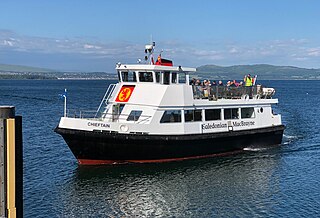
MV Chieftain, ex-Seabus, is a passenger ferry built in 2007 for Clyde Marine Services to run the Strathclyde Partnership for Transport (SPT) Gourock to Kilcreggan service on the Firth of Clyde.

The Amfibus is an amphibious bus, developed and built by DAT Vehicles B.V., in Nijmegen, Netherlands, which was considered as a replacement for the Renfrew Ferry across the River Clyde.
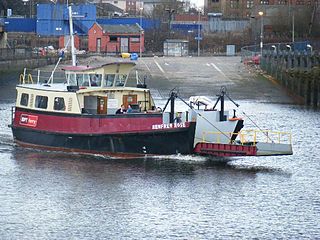
MV Renfrew Rose is a passenger ferry built in 1984. She operated as the Renfrew Ferry between Renfrew and Yoker until mid 2010 when she became the Arranmore ferry carrying up to three cars. Since 2016, she has operated the Cromarty to Nigg ferry.

Renfrew is a town 6 miles (10 km) west of Glasgow in the west central Lowlands of Scotland. It is the historic county town of Renfrewshire. Called the "Cradle of the Royal Stewarts" for its early link with Scotland's former royal house, Renfrew gained royal burgh status in 1397.

Erskine Ferry sailed across the River Clyde from Erskine to Old Kilpatrick. The ferry was also referred to as East Ferry of Erskine as there was another ferry to Dumbarton a few miles down river, known as West Ferry. It is reputed to be the oldest ferry crossing of the Clyde. The crossing was part of the A740 route from Paisley to Old Kilpatrick. It was established in 1777 and replaced by the Erskine Bridge in 1971.























